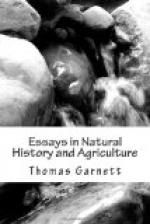I am quite aware that there is another theory which assumes that impregnation takes place twelve months before the exclusion of the ova. [8] But a very careful and long continued examination of the spawning of minnows and lampreys (I have never been able closely to examine the spawning of Salmon), convinces me that it is not a correct one. Besides, did any one ever succeed in hatching the ova of a fish which had not been allowed to come in contact with milt after exclusion? If they have, when, where, and how has this been accomplished, and where is it recorded? I know that I could never succeed, although I have often tried the experiment. On the other hand, it is the easiest thing imaginable, with due care and a suitable situation, to hatch those which have been properly impregnated after exclusion. But if, to avoid argument, I admit that this theory is correct, it will not at all interfere with artificial breeding of Trout and Salmon; on the contrary, it will materially facilitate it. It will only be necessary to catch female fish with the ova ready for exclusion, and place these ova in clean gravel in a box, as before described, but there will be no occasion for males. But supposing Trout and Salmon can be bred in this manner, which I by no means believe, there would be no means of breeding hybrids, which I consider a far more important achievement, and to which I will now refer.
Ever since my attention was turned to the artificial breeding of fish, it has always appeared to me exceedingly desirable and important to breed hybrids between the Trout and the Salmon. The fry of the Salmon, which, by-the-bye, is perhaps the most delicately flavoured fish that exists in this country, although it lives and thrives in fresh water for two or three years, if kept in a locality where it cannot escape to the sea, yet, if kept longer than that time, pines away and dies. If, therefore, we could obtain a hybrid fish, bred between the river Trout and the Salmon, we should probably produce a fish which, being a mule, would be always in good condition; being crossed with a river fish, it would probably never require a visit to salt water to keep it in good health. Being crossed with a Salmon, it ought to get to a good size in a comparatively short period; and, if it would rise at the artificial fly, or the minnow, ought to afford first-rate sport to the angler.
There does not appear to be a greater specific difference between the Trout and the Salmon than there is between the horse and the ass, between the mallard and the musk duck, or between a cabbage and a turnip. But hitherto, in all my experiments, I have never succeeded in producing a hybrid between the Trout and the Salmon. [9] Yet I do not despair of doing so, for there was always a something to complain of, and to doubt about, in every one I tried, and I still think I shall succeed by perseverance. Even if I shall succeed, the result may not prove quite so favourable as I anticipate, but may turn out as unfortunately




